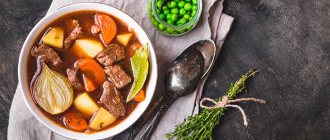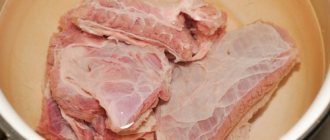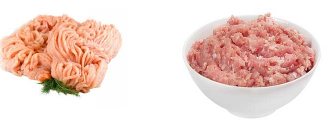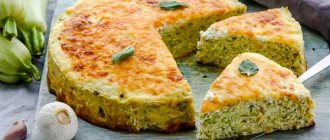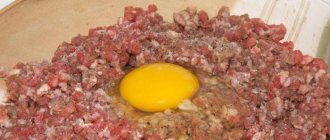Dietary properties:
How many calories are in ground beef, what dietary properties it has, all this is of great interest to those who lead a healthy lifestyle and monitor their health and figure. So we will try to answer these questions in the next article.
So here it is:
Ground beef is finely ground beef with fat and spices. In its preparation, only the sirloin part is used. And it should not include various by-products and other parts. Ground beef is often 80% meat and 20% fat (although the proportion can be adjusted to increase or decrease the fat content of the product).
Beef is a nourishing, nutritious and low-calorie variety of meat; it can be safely included in the menu of a person who wants to lose excess weight. Cattle meat is a rich source of B vitamins, which activate metabolic processes in the body.
Beef is quite rich in easily digestible animal protein. Athletes and people exposed to heavy physical activity can use it as an additional source of proteins.
Red beef meat contains B vitamins. Of these, B12 is especially important, which we can only get from animal products. Beef is a source of high-quality protein, without which the formation of cells, especially muscle cells, is impossible. The balanced composition of amino acids, including arginine and glutamine, as well as the presence of zinc, selenium, and iron, makes beef a product necessary for people.
Ground beef in other servings:
213
2.13
| Qty | A portion | Calories | In the counter |
| 100 g | 213 | ||
| 1 g | 2.13 | ||
| 60 | 1 ounce = 28.35g | 60 | |
| 181 | 1 serving (3 oz) = 85g | 181 | |
| 967 | 1 lb = 454g | 967 |
Composition of minced beef:
Vitamins:
| Vitamin: | IN 1 | AT 2 | AT 4 | AT 5 | AT 6 | AT 12 | RR | E |
| in mg. per 100 grams | 0.044 | 0.139 | 47.0 | 0.408 | 0.278 | 0.002 | 3.3 | 0.49 |
Minerals:
| Mineral: | Calcium | Phosphorus | Magnesium | Potassium |
| in mg. per 100 grams | 24 | 132 | 14 | 218 |
Vitamins, macro- and microelements contained in beef have a positive effect on the functioning of the nervous system. Regular consumption of dishes based on it reduces the likelihood of developing somnological disorders (insomnia, difficulty falling asleep, etc.), depression and neuroses, and helps reduce the negative impact of stress on our body.
“Minced beef” - in more detail:
- Ground beef (80% meat 20% fat)
- Cooked ground beef (80% meat 20% fat)
- Cooked ground beef (97% meat 3% fat)
- Cooked ground beef (95% meat 5% fat)
- Cooked ground beef (93% meat 7% fat)
- Cooked ground beef (90% meat 10% fat)
- Cooked ground beef (85% meat 15% fat)
- Cooked ground beef (70% meat 30% fat)
- Cooked ground beef (75% meat 25% fat)
- Cooked lean ground beef
- Cooked ground beef (80% meat 20% fat)
Recipe: Minced meat. Calorie, chemical composition and nutritional value.
Nutritional value and chemical composition of minced meat.
The table shows the nutritional content (calories, proteins, fats, carbohydrates, vitamins and minerals) per 100 grams of edible portion.
| Nutrient | Quantity | Norm** | % of the norm in 100 g | % of the norm in 100 kcal | 100% normal |
| Calorie content | 110.8 kcal | 1684 kcal | 6.6% | 6% | 1520 g |
| Squirrels | 16 g | 76 g | 21.1% | 19% | 475 g |
| Fats | 3.7 g | 56 g | 6.6% | 6% | 1514 g |
| Carbohydrates | 2.2 g | 219 g | 1% | 0.9% | 9955 g |
| Organic acids | 0.1 g | ~ | |||
| Alimentary fiber | 0.8 g | 20 g | 4% | 3.6% | 2500 g |
| Water | 76.7 g | 2273 g | 3.4% | 3.1% | 2963 g |
| Ash | 1.036 g | ~ | |||
| Vitamins | |||||
| Vitamin A, RE | 2.9 mcg | 900 mcg | 0.3% | 0.3% | 31034 g |
| Retinol | 0.003 mg | ~ | |||
| Vitamin B1, thiamine | 0.043 mg | 1.5 mg | 2.9% | 2.6% | 3488 g |
| Vitamin B2, riboflavin | 0.115 mg | 1.8 mg | 6.4% | 5.8% | 1565 g |
| Vitamin B4, choline | 53.23 mg | 500 mg | 10.6% | 9.6% | 939 g |
| Vitamin B5, pantothenic | 0.501 mg | 5 mg | 10% | 9% | 998 g |
| Vitamin B6, pyridoxine | 0.318 mg | 2 mg | 15.9% | 14.4% | 629 g |
| Vitamin B9, folates | 6.091 mcg | 400 mcg | 1.5% | 1.4% | 6567 g |
| Vitamin B12, cobalamin | 1.629 mcg | 3 mcg | 54.3% | 49% | 184 g |
| Vitamin C, ascorbic acid | 2.73 mg | 90 mg | 3% | 2.7% | 3297 g |
| Vitamin D, calciferol | 0.073 mcg | 10 mcg | 0.7% | 0.6% | 13699 g |
| Vitamin D3, cholecalciferol | 0.073 mcg | ~ | |||
| Vitamin E, alpha tocopherol, TE | 0.178 mg | 15 mg | 1.2% | 1.1% | 8427 g |
| Vitamin H, biotin | 0.245 mcg | 50 mcg | 0.5% | 0.5% | 20408 g |
| Vitamin K, phylloquinone | 0.3 mcg | 120 mcg | 0.3% | 0.3% | 40000 g |
| Vitamin RR, NE | 4.132 mg | 20 mg | 20.7% | 18.7% | 484 g |
| Niacin | 0.055 mg | ~ | |||
| Betaine | 5.673 mg | ~ | |||
| Macronutrients | |||||
| Potassium, K | 299.36 mg | 2500 mg | 12% | 10.8% | 835 g |
| Calcium, Ca | 15 mg | 1000 mg | 1.5% | 1.4% | 6667 g |
| Silicon, Si | 1.364 mg | 30 mg | 4.5% | 4.1% | 2199 g |
| Magnesium, Mg | 19.82 mg | 400 mg | 5% | 4.5% | 2018 |
| Sodium, Na | 49.09 mg | 1300 mg | 3.8% | 3.4% | 2648 g |
| Sera, S | 173.44 mg | 1000 mg | 17.3% | 15.6% | 577 g |
| Phosphorus, P | 159.8 mg | 800 mg | 20% | 18.1% | 501 g |
| Chlorine, Cl | 6.82 mg | 2300 mg | 0.3% | 0.3% | 33724 g |
| Microelements | |||||
| Aluminium, Al | 109.1 mcg | ~ | |||
| Bor, B | 54.5 mcg | ~ | |||
| Iron, Fe | 1.949 mg | 18 mg | 10.8% | 9.7% | 924 g |
| Yod, I | 0.82 mcg | 150 mcg | 0.5% | 0.5% | 18293 g |
| Cobalt, Co | 1.364 mcg | 10 mcg | 13.6% | 12.3% | 733 g |
| Manganese, Mn | 0.07 mg | 2 mg | 3.5% | 3.2% | 2857 g |
| Copper, Cu | 79.91 mcg | 1000 mcg | 8% | 7.2% | 1251 g |
| Nickel, Ni | 0.818 mcg | ~ | |||
| Rubidium, Rb | 129.8 mcg | ~ | |||
| Selenium, Se | 12.791 mcg | 55 mcg | 23.3% | 21% | 430 g |
| Fluorine, F | 8.45 mcg | 4000 mcg | 0.2% | 0.2% | 47337 g |
| Chromium, Cr | 0.55 mcg | 50 mcg | 1.1% | 1% | 9091 g |
| Zinc, Zn | 3.9336 mg | 12 mg | 32.8% | 29.6% | 305 g |
| Digestible carbohydrates | |||||
| Starch and dextrins | 0.027 g | ~ | |||
| Mono- and disaccharides (sugars) | 2.2 g | max 100 g | |||
| Glucose (dextrose) | 0.355 g | ~ | |||
| Sucrose | 1.773 g | ~ | |||
| Fructose | 0.327 g | ~ | |||
| Essential amino acids | 0.078 g | ~ | |||
| Arginine* | 1.058 g | ~ | |||
| Valin | 0.773 g | ~ | |||
| Histidine* | 0.51 g | ~ | |||
| Isoleucine | 0.7 g | ~ | |||
| Leucine | 1.229 g | ~ | |||
| Lysine | 1.307 g | ~ | |||
| Methionine | 0.403 g | ~ | |||
| Methionine + Cysteine | 0.005 g | ~ | |||
| Threonine | 0.614 g | ~ | |||
| Tryptophan | 0.085 g | ~ | |||
| Phenylalanine | 0.619 g | ~ | |||
| Phenylalanine+Tyrosine | 0.019 g | ~ | |||
| Nonessential amino acids | 0.181 g | ~ | |||
| Alanin | 0.992 g | ~ | |||
| Aspartic acid | 1.423 g | ~ | |||
| Hydroxyproline | 0.198 g | ~ | |||
| Glycine | 1.069 g | ~ | |||
| Glutamic acid | 2.397 g | ~ | |||
| Proline | 0.802 g | ~ | |||
| Serin | 0.631 g | ~ | |||
| Tyrosine | 0.487 g | ~ | |||
| Cysteine | 0.164 g | ~ | |||
| Sterols (sterols) | |||||
| Cholesterol | 45.09 mg | max 300 mg | |||
| Fatty acid | |||||
| Trans fats | 0.16 g | max 1.9 g | |||
| monounsaturated trans fats | 0.16 g | ~ | |||
| Saturated fatty acids | |||||
| Saturated fatty acids | 1.6 g | max 18.7 g | |||
| 12:0 Lauric | 0.004 g | ~ | |||
| 14:0 Miristinovaya | 0.091 g | ~ | |||
| 15:0 Pentadecane | 0.017 g | ~ | |||
| 16:0 Palmitinaya | 0.841 g | ~ | |||
| 17:0 Margarine | 0.038 g | ~ | |||
| 18:0 Stearic | 0.591 g | ~ | |||
| 20:0 Arakhinovaya | 0.007 g | ~ | |||
| Monounsaturated fatty acids | 1.45 g | min 16.8 g | 8.6% | 7.8% | |
| 14:1 Myristoleic | 0.017 g | ~ | |||
| 16:1 Palmitoleic | 0.112 g | ~ | |||
| 17:1 Heptadecene | 0.016 g | ~ | |||
| 18:1 Oleic (omega-9) | 1.388 g | ~ | |||
| 18:1 trans | 0.16 g | ~ | |||
| 20:1 Gadoleic (omega-9) | 0.01 g | ~ | |||
| Polyunsaturated fatty acids | 0.187 g | from 11.2 to 20.6 g | 1.7% | 1.5% | |
| 18:2 Linolevaya | 0.135 g | ~ | |||
| 18:3 Linolenic | 0.026 g | ~ | |||
| 18:3 Omega-3, alpha-linolenic | 0.021 g | ~ | |||
| 18:3 Omega-6, gamma-linolenic | 0.006 g | ~ | |||
| 20:4 Arachidonic | 0.025 g | ~ | |||
| Omega-6 fatty acids | 0.2 g | from 4.7 to 16.8 g | 4.3% | 3.9% |
The energy value of minced meat is 110.8 kcal.
Primary Source: Created in the application by the user. Read more.
** This table shows the average levels of vitamins and minerals for an adult. If you want to know the norms taking into account your gender, age and other factors, then use the “My Healthy Diet” application.
Application
Ground beef is usually used to prepare dumplings, cutlets, burgers, zrazy, casseroles and any other dish that you can think of using it. It is great as a filling for stuffed peppers and cabbage rolls. Even baking with it turns out excellent; minced beef can be used as a filling for waffle cones. Ground beef is widely used to make various sauces that have an excellent taste. An example of such a sauce is the legendary Bolognese, which perfectly complements the taste of many side dishes.
This section presents the calorie content of ground beef in various preparations, as well as the content of proteins, fats and carbohydrates. All data is provided per 100 grams of the finished product. To find out the BZHUK content, enter the required amount of product into the calculator.
Report errors and inaccuracies
- The calculations use the weight of only the edible part of the product.
Listed below are the nutrient standards that apply to the site.
Enter the amount of ground beef stew you need into the calculator to find out the calories, protein, fat, and carbohydrate content.
Enter the amount of ground beef stew you need into the calculator to find out the calories, protein, fat, and carbohydrate content.
Didn't find the product or dish you were looking for?
Let us know in a comment and we will add it:
Ground beef is meat from cattle, minced mechanically (in a meat grinder) or manually (with knives), often with the addition of spices and vegetables. It is eaten in cooked form. It is used in the preparation of various dishes, both separately and together with other food products.
Calorie content
100 grams of ground beef contains about 332 kcal.
Compound
The chemical composition of ground beef is characterized by a high content of proteins, fats, ash, vitamins (B3, B4, B5, B6, B9, B12, K), macro- (potassium, calcium, magnesium, sodium, phosphorus) and microelements (iron, manganese, copper, zinc, selenium).
How to cook
Ground beef is eaten mainly stewed or fried. Excellent compatibility with a huge number of other food products, as well as ease of processing and preparation, determine its very wide use in cooking. There are many recipes today that use ground beef. It is used in the preparation of many first and second courses, including sauces, salads and cold appetizers. Most often, ground beef is used in the preparation of cutlets, meatballs, meatballs and pates. In addition, this meat product often becomes a filling for various fried, boiled and stewed dishes, from pies to dumplings.
What goes with it?
As noted earlier, ground beef goes well with many foods, especially vegetables (potatoes and cabbage), cereals, pasta and baked goods, mushrooms, cheese, and nuts.
Composition of nutrients, BJU
Ground beef (90% meat 10% fat)
| For quantity: 100 grams | ||
| Calories — 176 | Calories from fat - 90 | |
| BJU | ||
| Total fat content | 10g | |
| Saturated | 3.93g | |
| Polyunsaturated | 0.34g | |
| Monounsaturated | 4.19g | |
| Cholesterol | 65mg | |
| Total carbohydrate content | 0g | |
| Dietary fiber | 0g | |
| Sugar | 0g | |
| Squirrels | 20g | |
| Vitamins and microelements | ||
| A - 4 µg | C - 0mg | |
| B-6 – 0.37 mg | B-12 - 2.21mcg | |
| D - 0.1 µg | E - 0.17 mg | |
| Calcium 12mkg | Iron 2.24 mg | |
| Magnesium 20mg | Zinc 4.79 mg | |
| Potassium 321 mg | Sodium 66mg | |
Distribution of calories for BJU:Carbohydrates (4%) Fats (51%) Proteins (45%) | ||
Calorie content of minced chicken
Minced chicken is one of the most popular semi-finished products in our country, which are always available.
This is an excellent raw material for preparing a large number of original dishes that are not only tasty, but are also dietary dishes due to the low calorie content of minced chicken. In cooking, meatballs and meatballs, cutlets, both steamed and fried, all kinds of casseroles and meat rolls are prepared from minced chicken. In addition, this product is often used in the production of belyashi, dumplings, cabbage rolls and pies.
When choosing minced chicken, you should pay attention to its appearance. High-quality minced chicken has a delicate pink hue. If the meat has darkened at the edges, it means that the minced meat has been on the display case for a long time. It is also worth saying that you need to choose chilled minced chicken, because it is in it that the beneficial properties of chicken meat are preserved. And if the minced meat is frozen, then you need to remember that it must be defrosted not at room temperature, but in a cool place, so that thawing occurs gradually.
The calorie content in minced chicken is 143 kcal per hundred grams of product. In addition, the calorie content of minced chicken includes microelements - phosphorus, iron, potassium, sodium and vitamins B, K, E, PP.
If you prepare minced chicken yourself, you can be sure of its freshness and composition, which should not contain anything other than chopped chicken meat.
As for store-bought products, things are different here. Sometimes unscrupulous manufacturers, in pursuit of monetary gain, add meat substitutes, soy, stabilizers, dyes and preservatives to minced chicken, which give the minced chicken an attractive appearance. In this case, we can hardly talk about the benefits of minced chicken, which looks appetizing, but does not carry the taste or aroma of natural chicken.
